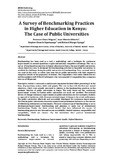| dc.contributor.author | Magutu, Peterson Obara | |
| dc.contributor.author | Mbeche, Isaac M | |
| dc.contributor.author | Nyamwange, Stephen Onserio | |
| dc.contributor.author | Nyaoga, Richard Bitange | |
| dc.date.accessioned | 2013-06-20T15:07:51Z | |
| dc.date.available | 2013-06-20T15:07:51Z | |
| dc.date.issued | 2011 | |
| dc.identifier.citation | Peterson Obara Magutu, Isaac Meroka Mbeche, Stephen Onserio Nyamwange, Richard Bitange Nyaoga;A Survey of Benchmarking Practices in Higher Education in Kenya: The Case of Public Universities,Vol. 2011 (2011), Article ID 357694, 20 pages DOI: 10.5171/2011.357694. | en |
| dc.identifier.uri | http://www.ibimapublishing.com/journals/IBIMABR/2011/357694/357694.pdf | |
| dc.identifier.uri | http://erepository.uonbi.ac.ke:8080/xmlui/handle/123456789/37000 | |
| dc.description.abstract | Benchmarking has been used as a tool, a methodology and a technique for continuous
improvements in sectoral operations to gain and maintain competitive advantage. This was a
survey of benchmarking practices in higher education in Kenya, the case of public universities,
whose objectives were; to document the benchmarking activities in the public universities; to
establish the challenges facing the public universities in benchmarking. Cross sectional survey
was used in this study to collect data from the six public universities with their respective
campuses/schools in the population of interest. The respondents were senior administrators
and the academic staff. Of the 53 informants who were sampled, 31 responded, thus, a response
rate was of 58 percent.
Descriptive statistics were used to analyze and summarize the data before presenting it in the
form of proportions, means, tables and graphs. This was in line with the first and second
objectives, which were actually answered in relation to the benchmarking practices in the
academic function of public universities in Kenya. The study found out that continuous
improvement systems in Kenyan public universities are good, not excellent. The external
drivers of change/continuous improvements in public universities are the customers/students
as opposed to legislation, while the major internal trigger of change is the actual performance.
The public universities effectively and successfully benchmark for continuous improvement.
The Kenyan public universities use action research and performance indicators as the sources
of referencing information on benchmarks. The most common type of benchmarking in use is
development/improvement benchmarking and planning to make use of international
benchmarking. Finally, the three critical factors that have influenced the success of
benchmarking practices are: time and resource availability: limited duration, comparability and
compatibility, which are reasons why the institutions don’t practice international
benchmarking. | en |
| dc.language.iso | en | en |
| dc.publisher | University of Nairobi | en |
| dc.subject | Benchmarking, Continuous Improvement, Quality, Higher Education | en |
| dc.title | A Survey of Benchmarking Practices in Higher Education in Kenya: The Case of Public Universities | en |
| dc.type | Article | en |
| local.publisher | Department of Management Science, School of Business, University of Nairobi | en |
| local.publisher | Department of Management Science, Narok University College | en |


